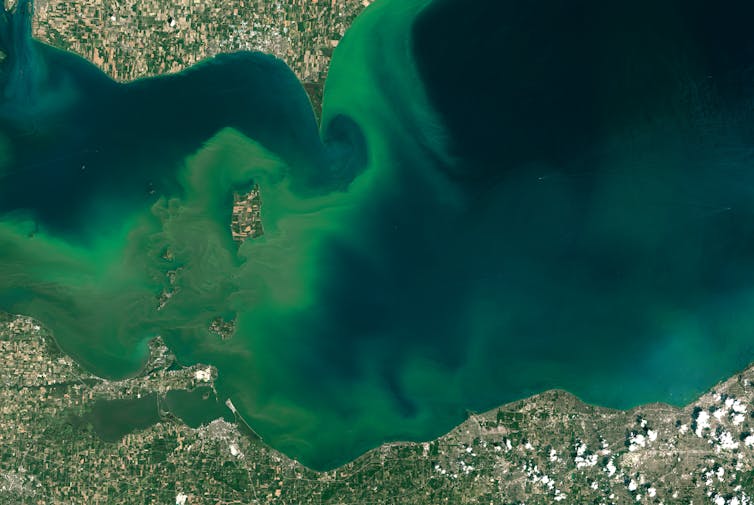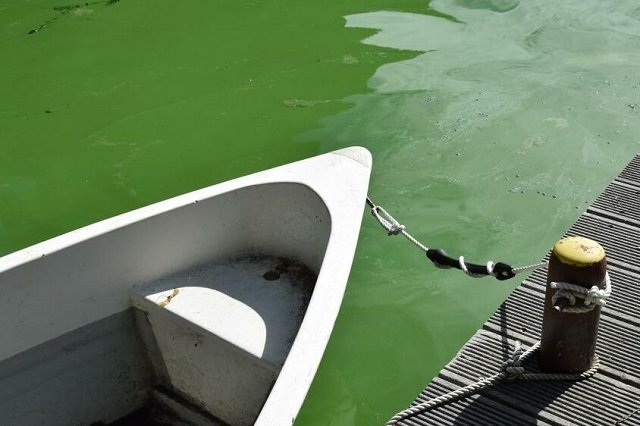Ohio, USA.- Walleye and the fish they eat struggle to see in water clouded by algae, and that could potentially jeopardize the species’ future if harmful algal blooms persist, according to a new study.
The research, led by Suzanne Gray of The Ohio State University, found that algae posed more of a threat to adequate vision than an equal amount of sediment – another common cause of murky waters in the western basin of Lake Erie.
The researchers found a decrease of more than 40 percent in the fishes’ ability to see in water clouded by simulated algae as opposed to water equally clouded by sediment. The study appears in the journal Conservation Physiology.
For many fish, vision is the primary tool for survival, leading them to food and away from predators that want to eat them.
“This is concerning for these important fish populations. If we can’t get a handle on algal blooms, this could threaten their well-being,” said Gray, an assistant professor of aquatic physiological ecology at Ohio State.
The researchers placed individual fish – six juvenile walleye and 17 emerald shiner – in round tanks of water surrounded by a rotating screen with alternating black and white stripes. The screen moved around slowly and, in clear water, the fish would naturally identify the pattern and swim circles in time with the rotating stripes.
“It’s an innate response for the fish to identify the difference between black and white and follow the screen,” Gray said.
Stay Always Informed
Join our communities to instantly receive the most important news, reports, and analysis from the aquaculture industry.
The researchers added increasing amounts of either sediment taken from Lake Erie or spinach (to mimic algae) to the tank. Emulsified spinach was used in this and a previous study because of its similarity in color, size and light-scattering properties to common algal bloom species.
After adding sediment or spinach, the researchers observed the behavior of the fish. When the fish stop following the moving stripes, they presumably can no longer see them, Gray said.
Though the amount of turbidity – a term scientists use to describe cloudiness in water – was equal with both substances, the fishes’ response was not.
They were far better equipped to see in water made murky with sediment than in the green, cloudy water created with the addition of spinach.
“The difference was way more profound than I expected. You could make the water really muddy and they would keep on swimming round and round, but you only had to add a little ‘algae’ and they would just sit there,” Gray said.
Increasing threats of harmful algal blooms in Lake Erie and in freshwater lakes and streams elsewhere are cause for widespread ecological concern, and it’s important to understand how they could be impacting fish populations, Gray said.
“This isn’t just an Ohio problem, it’s a problem all around the world,” she said.
The difference the researchers saw in this study may be because the fish have adapted to low-light vision (walleye hunt at dusk and dawn) in the intermittently muddy waters of the relatively shallow western basin of Lake Erie, she said.
“But algae is different. It’s green and it changes the light. It could be that both the reduction in light and the change in color inhibits vision differently than sediment,” Gray said.
Gray, who has studied fish around the world, became interested in walleye and the emerald shiner on which they feed not long after relocating to Ohio State.
It was 2014, and Toledo had just warned against drinking its water due to a major harmful algal bloom in Lake Erie that had found its way into the public water system.
“I saw an editorial cartoon showing an angler trying to fish in murky green water and saying something like ‘Can the fish even see the bait on my hook?’ and I thought that I could probably help answer that question,” Gray said.
Reference (Free):
Chelsey L Nieman Andrew L Oppliger Caroline C McElwain Suzanne M Gray. Visual detection thresholds in two trophically distinct fishes are compromised in algal compared to sedimentary turbidity. Conservation Physiology, Volume 6, Issue 1, 1 August 2018, coy044, https://doi.org/10.1093/conphys/coy044 https://academic.oup.com/conphys/article/6/1/coy044/5075448
Source: The Ohio State University
Editor at the digital magazine AquaHoy. He holds a degree in Aquaculture Biology from the National University of Santa (UNS) and a Master’s degree in Science and Innovation Management from the Polytechnic University of Valencia, with postgraduate diplomas in Business Innovation and Innovation Management. He possesses extensive experience in the aquaculture and fisheries sector, having led the Fisheries Innovation Unit of the National Program for Innovation in Fisheries and Aquaculture (PNIPA). He has served as a senior consultant in technology watch, an innovation project formulator and advisor, and a lecturer at UNS. He is a member of the Peruvian College of Biologists and was recognized by the World Aquaculture Society (WAS) in 2016 for his contribution to aquaculture.




